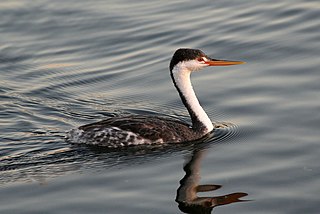
Grebes are aquatic diving birds in the order Podicipediformes. Grebes are widely distributed freshwater birds, with some species also found in marine habitats during migration and winter. Most grebes fly, although some flightless species exist, most notably in stable lakes. The order contains a single family, the Podicipedidae, which includes 22 species in six extant genera.

The great crested grebe is a member of the grebe family of water birds. The bird is characterised by its distinctive appearance, featuring striking black and white plumage, and elaborate courtship display that involves synchronised dances and displays.

The western grebe is a species in the grebe family of water birds. Folk names include "dabchick", "swan grebe" and "swan-necked grebe".

Clark's grebe is a North American waterbird species in the grebe family. Until the 1980s, it was thought to be a pale morph of the western grebe, which it resembles in size, range, and behavior. Intermediates between the two species are known.

The bird genus Hirundo is a group of passerines in the family Hirundinidae. The genus name is Latin for a swallow. These are the typical swallows, including the widespread barn swallow. Many of this group have blue backs, red on the face and sometimes the rump or nape, and whitish or rufous underparts. With fifteen species this genus is the largest in its family.

Saxicola, the stonechats or chats, is a genus of 15 species of small passerine birds restricted to the Old World. They are insectivores occurring in open scrubland and grassland with scattered small shrubs.

Lullula is the genus of woodlarks, songbirds in the family Alaudidae. There is only one remaining extant species, the woodlark which is found in Europe, the mountains of northern Africa, the Middle East and western Asia. The remainder are known only from the fossil record.

Podiceps is a genus of birds in the grebe family. The genus name comes from Latin podicis, "rear-end" and ped, "foot", and is a reference to the placement of a grebe's legs towards the rear of its body.

Galerida is a genus of birds in the family Alaudidae. The current scientific name is derived from Latin. Galerida was the name for a lark with a crest, from galerum, "cap". The name Galerida is synonymous with the earlier genus names Calendula, Heliocorys and Ptilocorys.

The Saint Helena hoopoe, also known as the Saint Helena giant hoopoe or giant hoopoe, is an extinct species of hoopoe known exclusively from an incomplete subfossil skeleton. Once endemic to the island of Saint Helena, it was last seen around 1550, likely driven to extinction by various aspects of human activity.

Aegithalos is a genus of passerine birds in the family Aegithalidae (bushtits), encompassing majority of the species in the family.

Parus is a genus of Old World birds in the tit family. It was formerly a large genus containing most of the 50 odd species in the family Paridae. The genus was split into several resurrected genera following the publication of a detailed molecular phylogenetic analysis in 2013. The genus name, Parus, is the Latin word for "tit".

Palaelodidae is a family of extinct birds in the group Phoenicopteriformes, which today is represented only by the flamingos. They were widespread during the Neogene, with fossil remains found on all continents other than Antarctica. The oldest remains referred to this group appeared in the fossil record during the Oligocene in Egypt and Belgium, before palaelodids reached their peak diversity during the Miocene. Following this the group declined in the early Pliocene before going extinct on most continents. However, remains found near Cooper Creek in the Lake Eyre Basin indicate that palaelodids managed to survive in Australia until the Pleistocene. Currently three genera are recognized by scientists: Adelalopus, Palaelodus and Megapaloelodus. Most fossil remains stem from Europe and have been assigned to the type species, Palaelodus ambiguus. Due to the fragmentary nature of most of these species, little is known about their ecology. They appear to have preferred brackish lakes and lagoons. Palaelodus has previously been thought to be a wader or diver, but recent research indicates that they were better suited for swimming and possibly fed on insect larvae and other aquatic invertebrates. At least Megapaloelodus appears to have adaptations for "locking" their legs in a standing position.

Thiornis is a fossil genus of Middle Miocene grebe known from a nearly complete specimen from Libros, Spain. Originally classified as a type of moorhen, Thiornis has since been classified as a species of grebe. The overall anatomy of the bird is identical to modern grebes. It contains a single species, T. sociata.
Podilymbus majusculus is an extinct species of grebe recovered from the Piacenzian age of the United States.

Podicipedini is a tribe of waterbirds belonging to the family Podicipedidae containing the genera Aechmophorus and Podiceps. Members of this tribe of grebes are characterized based on the presence of nuptial plumes and downy young with a bare crown patch. They are more specialized for diving though the anatomy that enables them to do so makes them weaker to stand upright. Further they have much complex mating dance rituals. Based on these characteristics, other possible genera in the clade include Poliocephalus and Rollandia. Indeed a molecular phylogeny by Ogawa et al. (2015) using genetic data from 3 mitochondrial markers found Podiceps to be paraphyletic in respect to Rollandia, as the latter genus is more closely related to several New World species of the former genus. The inclusion of the Neogene genera of Pliolymbus and Thiornis is based on their possible reclassification as junior synonyms as Podiceps.
Podiceps oligoceanus is an extinct species of grebe possibly from the Neogene period which the specimen has been found in the United States.
Podiceps dixi is a possible extinct species of grebe from the United States.

Podiceps miocenicus is an extinct species of large Late Miocene grebe from Moldova.
Podiceps solidus is an extinct small species of Upper Miocene to Lower Pliocene grebe from Western Mongolia.















